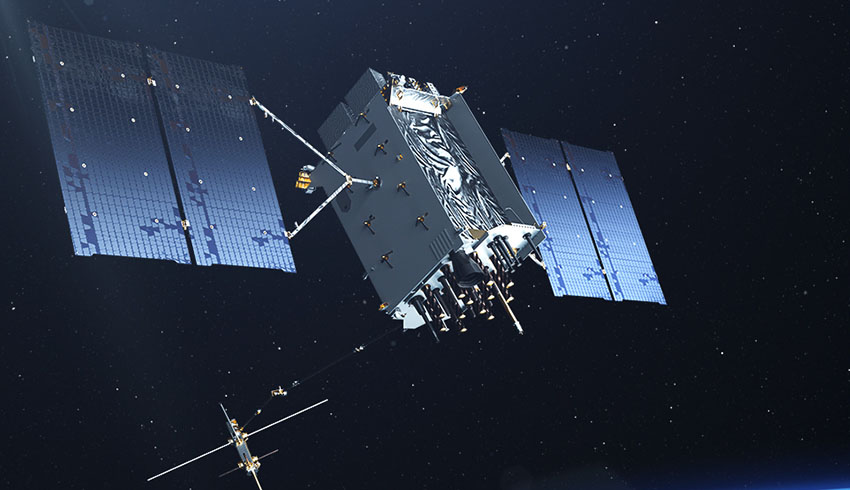With the battlefield of tomorrow driven and controlled by communications and information, it is vital to know the impact an aggressor would have should these assets be disabled in a conflict.
onflict.
Why space matters to Defence
The general public often forgets the importance of space in their everyday lives. The ubiquitous GPS (global positioning system) is a satellite system that provides precise position, navigation and timing capabilities to our iPhones, fitness devices and general satellite navigation products.
GPS satellites also provide our Defence Force with the capability to pinpoint enemy locations, aid in search and rescue missions, even to find shelter for troops under fire. In fact, every mobile or kinetic system, including precision guided weapons, relies on GPS to accurately navigate to fixed targets.
Meanwhile, Intelligence, Surveillance and Reconnaissance (ISR) satellites – often referred to as “spy” satellites – inform Defence and Intelligence communities of concerning developments in urban environments or on the battlefield. ISR satellites provide real-time data associated with enemy and friendly troop or vehicle movements; they are used to keep track of those who seek to do harm to our nation, and give advance notice of incursions in or near Australia’s borders from maritime or airborne threats.
Communications satellites (SatCom) enable Defence personnel to maintain contact with each other anywhere in the world and to deliver updates from ISR satellites and other sensors in the field. SatComs support unmanned drones and vehicles on land that operate semi- or fully autonomously. Indeed, future systems will need a combination of GPS navigation sensors and satellite communications to deliver the potent response we will need to fight and win.
More recently, internet of things (IOT) technologies are enabling a large number of sensors (thermal/infrared, among others) to be deployed into the battlefield, relaying information through an orbiting satellite to command and control locations.
Without these critical assets in space, our Defence Forces could effectively be rendered inoperable, relying on World War II-like communications technology (as described in a 2017 AARC article by Lieutenant Colonel (Ret’d) Greg Rowlands), and our multibillion-dollar strategic and tactical assets, such as the F-35, Growler and P-8A, would have their capabilities severely degraded.
What has changed
We can no longer assume that satellites are safe in orbit. Key adversaries have already demonstrated potent anti-satellite (ASAT) weapon systems from Earth and in space, proving that all of our key communications infrastructure are at risk as high-value targets.
The Russian, Chinese and Indian armed forces, among others, have successfully tested ASAT missiles. The Chinese are purported to have the ability to attack geostationary satellites over 36,000 km in altitude, and the Russians recently put to test small satellites capable of changing orbits to “shadow” larger reconnaissance satellites. Indeed, the latter’s potential to destroy strategic satellites in orbit has generated great concern in our key ally, the US.
What’s more, given recent geopolitical events, we can no longer assume that our allies will come to our aid with launch and satellite technology. They too could be suffering similar losses, and in such cases would likely prioritise their own national interests.
Our response…?
It is vital for Australia’s Defence Force to recognise that today our satellite network has the same strategic importance as an Air Force base, an Army tank platoon or a Navy destroyer, and that it is significantly more vulnerable to threats.
A coordinated attack from a capable adversary could destroy a significant number of our key defence and civilian satellites within 24 hours, altering our way of life and ability to defend ourselves faster than any virus ever seen.
In this new world, tactical responsive and sovereign space is no longer just a “nice to have” but a Defence capability that would ensure we have:
- back-up satellites ready to be placed into orbit;
- the ability to launch and replace destroyed or damaged satellites within a 24-hour period in the event of a conflict;
- to control when and where these satellites are placed (perhaps even launching ISR satellites to specific orbits over troubled areas); and
- directly protect and control the launch site they are launched from.
Standard military doctrine requires key assets/equipment (tanks, fighter planes, ships etc) to be held in reserve during a sustained conflict. The size of this reserve or “magazine” is monitored across a whole range of Defence systems. Our magazine in space is zero.
Sovereign space, responsive launch
The good news is that Australia is naturally blessed with a coastline that would allow us to launch into almost every orbit possible from Earth. Very few countries have that capability today, making an Australian launch capability valuable to our allies for their own tactically responsive space needs.
What is also significant and different now is that there are Australian companies working on small satellite manufacturing (e.g. Skycraft, Inovor), orbital launch vehicles (Gilmour Space) and launch sites (Southern Launch, Equatorial Launch) to support this sovereign launch capability.
With relatively small investments from Defence, these Australian companies could be producing ‘mission-ready’ space vehicles within the next two to three years.
As ASPI’s senior analyst, Malcolm Davis, highlighted: “Australia’s space industry can directly support Defence’s space requirements in coming years through local development of small satellites for defence purposes, and to build the capability to launch those Australian satellites on Australian launch vehicles from Australian launch sites.”[ii]
Decisive action will be needed for Australia to have its own sovereign space and launch capabilities, to manufacture and secure its own supply chain, to support our allied interoperability in space, to protect our cherished way of life and our national security – all of which should be brought together by an Australian Space Force.
It’s time for a Defence strategy that encompasses land, sea, air, cyber – and space.
Adam Gilmour is the CEO and founder of Gilmour Space, a leading Australian orbital rocket and launch company based in Queensland, which recently signed a collaborative agreement with the Defence Science Technology group.

